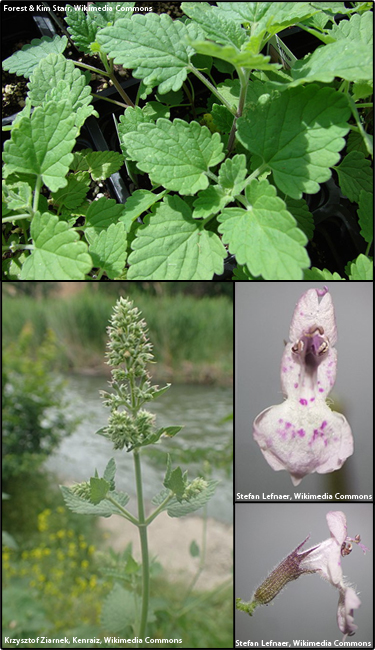Catnip (Nepeta cataria)
 Common Names: Catmint, catwort, field balm
Common Names: Catmint, catwort, field balmDescription: Historically used as a medicinal plant.
Habit: Erect perennial that emits a mint odor when crushed.
Leaves: Opposite, hairy, triangular or heart-shaped, pointed tips. Upper surface is pale green while lower surface is covered with dense hairs appearing white or silvery. Serrated edges, long slender petioles. Emits a mint odor when crushed.
Stems: Erect, growing 1-3 feet tall, square, pale green in color, branched, covered with short white hairs.
Flowers: 1/2 inch long, 5 petals united into a 2 lipped tube. Upper lip has 2 lobes while lower lip as 3 lobes, is larger and spotted. White to pale lavender in color with dark purple spots. Whorled, dense clusters borne at the tips of stems and branches.
Fruit and seeds: Pod containing 4 seeds. Seeds are oval, smooth, red-brown in color with 2 white spots at one end.
Habitat: Native to Europe and Asia. Can be found in dumps, parking lots, old homesites, fields, thickets, roadsides, railroads, shores, flower beds and disturbed sites.
Reproduction: By seed or vegetatively by rhizomes.
Monitoring and rapid response: Hoeing and repeat mowing can be used to control this species. Mowing should begin in the spring and repeated often to prevent shoot growth. Credits: The information provided in this factsheet was gathered from The Ohio State University College of Food, Agricultural and Environmental Sciences.
Individual species images that appear with a number in a black box are courtesy of the Bugwood.org network (http://www.invasive.org).Individual photo author credits may not be included due to the small display size of the images and subsequent difficulty of reading the provided text. All other images appear courtesy of Google (http://images.google.com).
